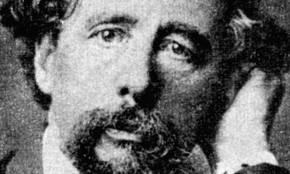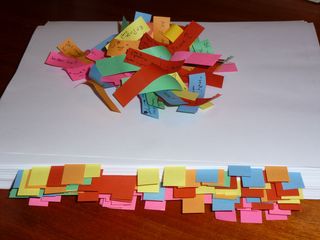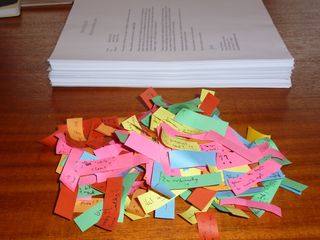|
Maybe I will repost this after the book is out so that the overlaps here will blow your mind as much as they blow mine (i.e. after you have -- I hope I hope -- read the book), but this just happened, so now seems a good time to write about it. As you maybe heard, last week at the Coachella music festival, rapper Tupac Shakur made a surprise onstage appearance and gave a stirring, provocative performance. This was especially stunning since he was shot to death fifteen years ago. The ways in which this blows my mind are numerous. For starters, it wasn't, as you'd at first assume, archived footage -- that is, the audience was not just watching a cleverly projected film of a previous performance. Digital Domain, the company responsible for the image, promises, "This is not found footage. This is not archival footage. This is an illusion." Note the boast here: it's not real; it's an illusion. It seems more and more like what impresses us as a society is not what's real but what isn't real. The projection technology, meanwhile, the technology that makes this look so real and so believable, is decidedly low tech, shockingly low tech in fact. The Tupac appearance was quickly dubbed a hologram which just as quickly caused a zillion people to post online about how in fact it was 2-D whereas a hologram is in fact 3-D. This turns out to be smoke and mirrors, well, mostly mirrors actually. It's projected on mylar so one can both see it and seethrough it so that Dr. Dre and Snoop Dogg can appear live and rap with Tupac, and you see all of them. I was thinking of Disney's Mary Poppins (1964) where Julie Andrews and Dick Van Dyke interact with animated animals. I was off. By a hundred years. In 1862, this same essential technology was used to dramatize a Dickens novella.Charles Dickens. 1862. Now they're talking about a tour. My question is this: is that a technological miracle, a resurrection, the chance for a whole new generation of fans to see a performer there was seemingly no chance they ever would? Or is it going to the movies? To summarize: 1) This technology: so unfathomably impressive and advanced, it seems the stuff of science fiction 2) This technology: so old, it was first used by the Victorians 3) This technology: so mundane, it's essentially a movie Charles Dickens: Dead. But real. Discuss.
Today I read this remarkable Guardian article about Toni Morrison with whom I fell in love in college. She's incredible, and the article says a great many interesting things, but the one that stopped me was this: "It is hard to believe Morrison is 81. She started late, her first novel, The Bluest Eye, written when she was 39 and a senior editor at Random House."
First off, 39 is late? Really? Maybe it's not early but late? The New Yorker's up and comers list is "40 Under 40," and that seems about right to me. Writers under 40 count as young, early, up and coming, ahead. This is not to say that writers over 40 are old or late or behind -- not at all, in fact -- but calling 39 late seems strange to me. I imagine what this writer really means is that Morrison is so talented and so decorated (i.e. she's a Nobel Laureate in addition to quite a few other remarkable honors), and we somehow expect that kind of talent to be inherent, built-in, inborn rather than earned or developed. This brings me to what strikes me as the second remarkable, thrown-away point in those couple sentences: she was a senior editor at Random House at the time. No matter how inherently talented you are, writing good books (or, hell, bad books) takes time. Lots of it. So does being a senior editor at Random House. So does rising to be a senior editor at Random House. This is also part of why 39 seems young. Morrison went to college, then graduate school, then taught at a couple of colleges for a few years, then was a textbook editor before becoming a senior fiction editor and finishing her book. That's not late -- that's pretty much right away. She can eat off writing novels now, sure, but no one starts off that way. Third is that innocent little "and." "...her first novel, The Bluest Eye, written when she was 39 and a senior editor at Random House." Lots of us -- most of us probably -- write our first novels with an "and." We have a job and we write. Lots of us also have kids. Morrison had two and was raising them solo and was a senior editor at Random House and was writing her first novel. Later in the article, it says she got up at 4:00 every morning to write. It strikes me that she could reasonably have gotten up at 5:00 instead or written every other morning or just on weekends, published her first book at 45 or 47 instead of 39, and still been ahead of the game. And then there's this bit: "It is hard to believe Morrison is 81." It's not clear if that's because she seems younger or because it seems like she was so recently 39 and publishing her first book or because it seems strange in our culture to be publishing novels -- as Morrison is this summer -- at the age of 81, but I gather it's the latter. There's much in the article about her always napping after lunch, never having to feel guilty about anything anymore at 81, forgetting where her keys are and what they're for, having a clear picture of the past just not the present. It's interesting this impression that writing is for young people -- 39 is late to start, 81 is old to publish -- when it seems in so many ways like it'd be the opposite. Is it cultural? Other cultures value the wisdom and experience of their elders more than we do? It also seems to me to tie into all of the above: when your children are raised, when you don't have to work full-time at a non-writing job to support your writing, when your head isn't full of parenting and working, when you aren't so sleepless and exhausted, when you've had some education and life experiences and perspective, when your past is clearer than your present, when your past is presenter than your present...that seems to me like exactly the time to be writing novels. First Pass Pages It kind of seems appropriate to start at the end though I didn't do it that way to be clever. I did it that way because, until the book was done, there was no time to blog. It's also funny how the very last step is called first pass pages, but so it is. I asked my editor this week if I could see second pass pages, and she said, "Nobody sees second pass. I think we let Bill Clinton see it, but that's it." So unless I become president, which seems on the whole unlikely (especially between now and August), first pass is last pass. First pass is all about commitment. They send you typeset pages, the actual pages from the actual book, and it's your very, very, very last opportunity to catch any typos or make any changes to the text before it goes to print, so whatever you decide, you're stuck with it forever. Writing a book is a long process which takes a long time during the whole of which I am always putting things down and thinking, "I'll fix it later. I'll fix it later." First pass pages is the end of later. Here was first pass, round one: Each of those flags is something to go back and reread, rewrite, consider, adjust. These aren't big things -- big things got addressed in copyedits, edits, revisions, drafting. These are: do I want "said Sam" or "Sam said" and do I mean, "Hi, honey" or "Hi honey" and "started" or "begun." So, maddening. Here's round two...some progress, but not a lot. There were four rounds total before I dispensed with all the post-its. These decisions seem nitpicky, and they are nitpicky, but first pass is really the first moment available to consider that level of minutia. I'll write more about the other steps of the process in future posts, but for the moment, I'll say this about first pass: it's the only time you can consider whether you want "said Sam" or "Sam said." And while it's not a devastating decision certainly, it does matter, at least a little bit. Eventually, every single last flag got considered, addressed, handled: And then there was celebrating with the three-year-old set (sparkling apple juice in champagne glasses, straws optional) which was actually less a celebration and more of a ceremony, a blessing before sending the thing on its way in the world, before letting it rest for the evening and then putting it in the mail in the morning.
Book-writing is a long journey that ends not with a bang but with a huge pile of (pretty) post-it notes. Meantime, welcome to the blog. Thanks for being here. Comments welcome -- here, Facebook, Twitter, email...whatever you prefer. |
About The AuthorLaurie Frankel writes novels (reads novels, teaches other people to write novels, raises a small person who reads and would like someday to write novels) in Seattle, Washington where she lives on a nearly vertical hill from which she can watch three different bridges while she's staring out her windows between words. She's originally from Maryland and makes good soup. Archives
October 2023
Categories
All
|




 RSS Feed
RSS Feed